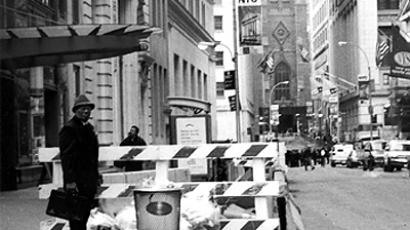DC's homeless to be left in the cold this winter

Residents of the Washington DC metropolitan area make on average the largest annual income of any region in America. The nation’s capital also boasts a homeless population that is unmatched by many locales from coast-to-coast.
As wintery weather begins to leave a frost on the banks of the Potomac, the thousands of impoverished citizens in the District of Columbia are trying to find a roof to stay warm in while snow begins to bluster. For many, however, they will be out of luck this season. Earlier this month, David A Berns of DC’s Committee on Human Services told those in attendance at a roundtable hearing that the recession had ravaged economic conditions for DC residents. Although the District boasts the highest average annual income in the country, the official tally of homeless persons on the streets of the city is at 6,546. With more and more people unable to make ends meet, they are leaving their homes and hitting the sidewalks and parks of Pennsylvania Avenue and the shelters that pepper the city’s turf. Those same dire economic circumstances has caused a cut in funding as well, and as more Washingtonians are forced onto the streets and rely on the aid of others, that helping hand is shriveling up as the city goes broke itself.“New information from just the last few days may require the District to rethink both its Winter Plan and the allocation of resources within the shelter program,” Bern testified on October 20. Typically the city’s Interagency Council on Homelessness develops its Winter Plan before each cold-season to figure out how to best help those that would otherwise go without a roof overhead. With more men and women being left out in the cold and funds trying up, this winter might prove to be a disastrous one for the city’s homeless.This past week, Washington DC already experienced its first snowfall of the year. Officially, the city cites its cold weather season as stretching until March 31. Until then the District will extend a series of initiatives to help aid the homeless, but many are likely to suffer.The city believes that of the 6,546 homeless people residing in DC, 858 families help make up that figure, which also includes more than 1,600 children. This year’s Winter Plan originally yielded an estimate that the city would need accommodations for 366 needy families, but as Street Sense reports this week, DC currently comes up short by 57 spaces. Between April and November, 1,007 families requested bedding from the city’s Interagency Council on Homelessness, though only 37 families have so far been placed into housing.As RT reported last week, the 5.6 million residents in the metro DC region combined bring in around $221.4 billion each year; however, 11 percent of DC-proper qualifies as “very poor,” meaning a family of four makes under $11,000 annually.According to the U.S. Department of Housing and Urban Development, the average fair market monthly rent for a two-bedroom apartment in the District is $1,506. The average homeless adult, however, only makes a fraction of that at $600 monthly. To The Washington Post last week, Rafael Cruz, 50, said he can earn a few hundred dollars a week during odd jobs, but even finding a $500 apartment is not within reach. As a result, he has lived on the streets of DC for four years now.“If Barack Obama did what he was supposed to do, we wouldn’t be in this shape,” Cruz told the Post from the Occupy DC encampment, where he is among other homeless welcomed in by protesters from around the country. “He put the money for schools and jobs and he put it in Wall Street. … I’m waiting for a tent because I want to go protest.”Only a few miles down Route 1, the city of Baltimore, MD recently lost bedding for around 100 of the city’s homeless. As RT reported earlier, around 700 adult women are homeless in Baltimore, but 24-hour shelters are few and far between — and the new $8 million shelter the city just unveiled closes the door once it reaches capacity, only to send men to overflow shelters and the women back onto the streets.In the District, 2011 saw an increase of 7 percent in the number of families gone homeless since the year prior.














